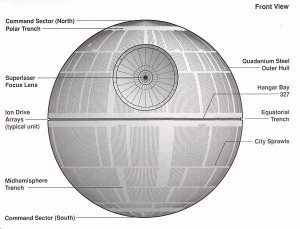When George Lucas released the first of his Star Wars series back in May of 1977, no one suspected the movie’s impact on popular culture. But it was certainly a day long remembered. Even after countless novels, tons of action figures, and several video games, the Star Wars universe continues to expand, and with it, the excited imaginations of its followers.
 Being the fanboy that I am about Star Wars, I struggled with this piece. I wanted to write about so much, yet both Carrie and I were tasked with only writing specific focuses. And I must admit, writing about the rebels would be fun. But when I think about it more, that level of excitement is insignificant next to the joy of talking about the “Dark Side”, more specifically the Empire. Unfortunately, after I read Carrie’s post, I sort of lost faith that I would write something as worthy…a lack of faith I found disturbing indeed.
Being the fanboy that I am about Star Wars, I struggled with this piece. I wanted to write about so much, yet both Carrie and I were tasked with only writing specific focuses. And I must admit, writing about the rebels would be fun. But when I think about it more, that level of excitement is insignificant next to the joy of talking about the “Dark Side”, more specifically the Empire. Unfortunately, after I read Carrie’s post, I sort of lost faith that I would write something as worthy…a lack of faith I found disturbing indeed.
Those of you familiar with the Star Wars universe probably know that the Empire was started when the then Chancellor Palpatine reorganized the Republic (which had previously endured for over 25,000 years) into “the first Galactic Empire.” This empire was powerful and resourceful. And I bet many businesses today could only dream of having as wide a reach as Palpatine’s Empire. There is so much that the Empire can teach us about how to build and hold such a large organization together.
So where should I begin my discussion of the Empire? Well, it is very difficult not to talk about the Empire without mentioning the Death Star. The Death Star was a large battle station, which was the size of a small moon. It had a “superlaser” on one side that could destroy an entire planet in a single shot. With this weapon, the Imperial forces hoped to keep a solid grip on its member planets. Unfortunately, the Death Star had a fatal flaw.
This brings us to the first of our lessons that the Empire teaches us. A flaw, no matter how small, can disrupt even the largest of systems. In the case of the first Death Star, there were small gaps in the shielding small enough to let small ships through. To top that, there was also an exhaust vent that Luke Skywalker was able to use to destroy the first Death Star. Despite being this massive fortress in space, the entire battle station was taken out by two simple torpedoes fired into a hole about 2 meters wide. So keep that in mind when designing any system. Whether it is a physical system like shelving or it is something more programmatic like a software program, look for flaws. Simple mistakes can bring down entire buildings, topple bridges, and crash large networks if you are not careful.
And be prepared with a backup or disaster recovery plan, just in case the original plans fail. That is a good lesson that businesses can learn from the Empire. After the destruction of the first Death Star, the Empire had immediately started construction of backup battle station, one that was more powerful and more secure than the first.
The Emperor knew not to put all his trust in a single battle station. He had made sure that resources were in place to start another if the first had failed. Ultimately, that station too was destroyed by Alliance fighters Wedge Antilles and Lando Calrissian. But the Empire did not give up there. They had started construction of yet another Death Star (which doesn’t appear in any of the movies currently).
If you have an organization which relies on key systems, make sure those systems can be rebuilt quickly if they are destroyed. Create backups of your critical data. Have extra hardware available and people trained to hook them up within a few hours. More importantly, have a plan in place. Disaster recovery plans are the key to surviving unexpected events like a would-be Jedi firing torpedoes at you. As Vader once said it is, “unwise to lower your defenses.”
Now it may seem the Empire was rather single minded about the whole Death Star thing, but honestly, they did learn from their original mistakes (as we all should strive to do). I mean, the second Death Star was a vastly improved model over the original. Learning from their original blunder, this time the Empire used stronger shielding to protect it. This shield protected it from those small ships that doomed the first station. If it wasn’t for the fact that the Rebels befriended a bunch of walking teddy bears, the second Death Star may have forced the Rebel fleet to retreat. But as a result of Ewok intervention, the shields were taken out and (once again) the battle station was left somewhat vulnerable to small ships, which again only reemphasizes the first lesson to follow.
There was not going to be a small hole to shot torpedoes into this time though. Nope. The Empire learned from that first mistake. The exhaust port was improved so that many tiny exhaust vents were installed instead. And these vents would automatically close in case there was energy detected. But unfortunately, the second Death Star was not yet fully built, meaning there were LARGE TUNNELS still left open which the small ships could fly through to reach the power core directly.
Despite their failure, we do need to be more like the Empire, and learn from our blunders. If something fails, let’s find out why. Research the problem and come up with solutions to those problems. The Empire surely learned from their original lessons regarding the destruction of the first Death Star. The second was destroyed by a set of new issues, not the same ones as before. That said, one mistake the Empire never seemed to learn from was one regarding security.
The first Death Star was destroyed because the Rebels were able to examine stolen data regarding the station. Those plans were what revealed the flaw in the Death Star. Secure plans, even though it was initially leaked as a trap by the Emperor. Security was ultimately the downfall of the second Death Star as well. Had the Emperor not leaked the information about the Death Star II, the Rebels would have been too late to stop it. Those tunnels which the fighters traveled through would not have been available. The vents and shielding would have worked as designed, and the battle station would have become the ultimate power in the galaxy…again.
Security therefore is an important lesson that our businesses must learn. Competition can be fierce, and we don’t want to give our competitor an advantage over us. Keep company secrets secure. Train staff to think in terms of security. Make sure they don’t open unsolicited email links to prevent virus attacks, Trojans, and other such hacks. Have team members run routine scans on their systems and block viewing of unapproved and unsafe websites when possible. Educate them on why security and safety are necessary and important. Let them start out as a learner and nurture them into becoming security masters.


Pingback: Thill Logisitcs
Thank you for sharing excellent informations. Your web-site is so cool. I’m impressed by the details that you have on this blog. It reveals how nicely you perceive this subject. Bookmarked this website page, will come back for more articles. You, my pal, ROCK! I found simply the information I already searched everywhere and simply could not come across. What a great site